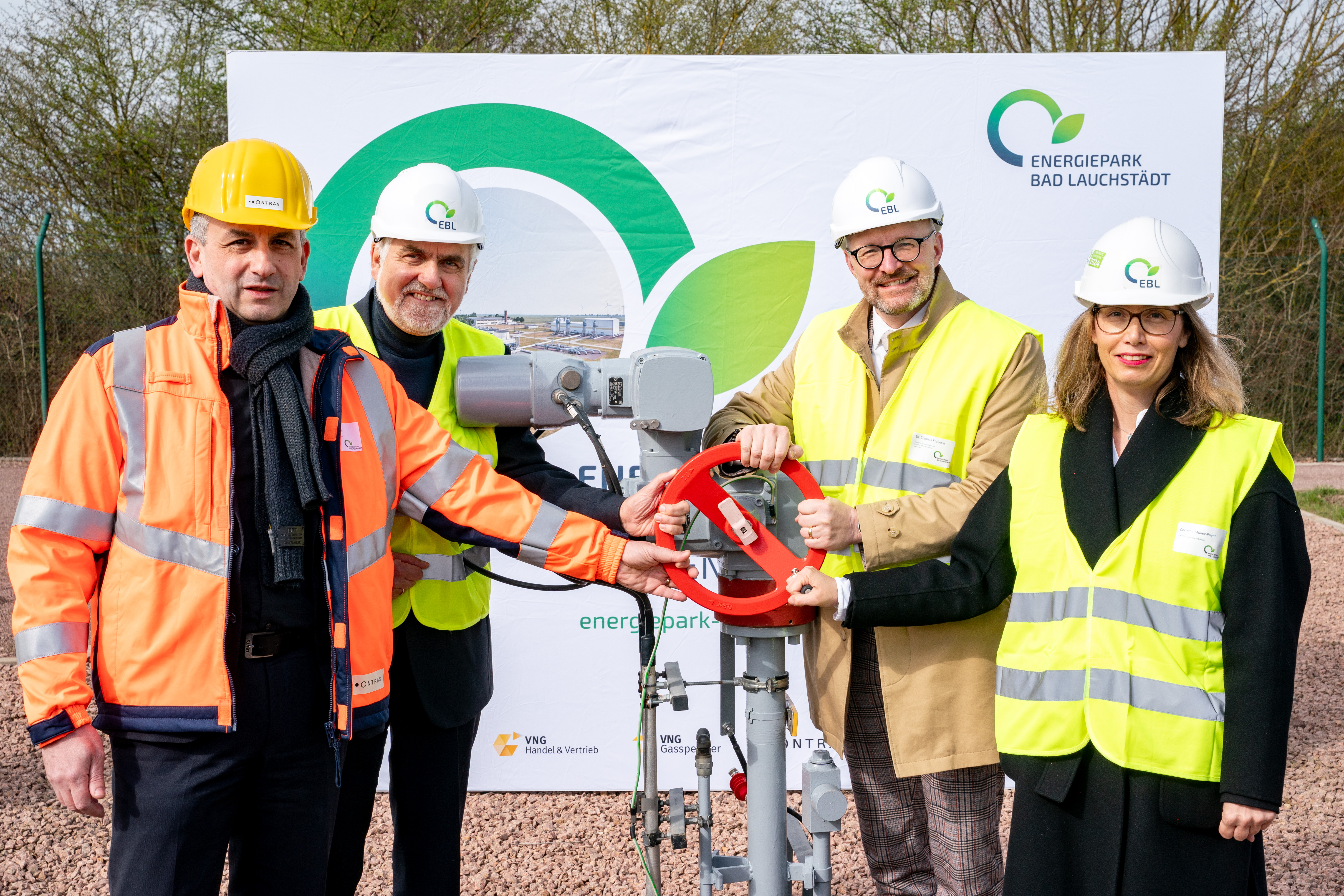Press releases
08.04.2025
ONTRAS commissions gas pipeline from Bad Lauchstädt Energy Park – first section of the hydrogen core network in Eastern Germany
With the initial charging of the pipeline with gas, several milestones have been passed: On the one hand, work on a further value-added stage of the Energy Park has been concluded and the pipeline is now ready to transport hydrogen. On the other, with this pipeline section, ONTRAS has completed the first section of the hydrogen core network in Eastern Germany and hence also the initial section of the ONTRAS H2 start-up network.

Press release of the Bad Lauchstädt Energy Park
• Conversion of 25 kilometres of existing pipeline from natural gas to hydrogen completed
• Next level of value creation at the Bad Lauchstädt Energy Park comes on stream
• It also creates the entry point for the ONTRAS H2 start-up network, establishing connections from the Bad Lauchstädt Energy Park to the West and East
At the Bad Lauchstädt Energy Park (“EBL”), the 25-kilometre gas pipelines to connect the electrolyser currently under construction with the TotalEnergies Central Germany Refinery in Leuna goes into operation. With the initial charging of the pipeline with gas, several milestones have been passed: On the one hand, work on a further value-added stage of the Energy Park has been concluded and the pipeline is now ready to transport hydrogen. On the other, with this pipeline section, ONTRAS has completed the first section of the hydrogen core network in Eastern Germany and hence also the initial section of the ONTRAS H2 start-up network. As the centrepiece, the long-distance gas pipeline (FGL) 701 enables the connection of further projects of the hydrogen core network, such as Green Octopus Central Germany (GO!) in the Magdeburg-Salzgitter area or the Central Germany “Chemical Triangle” and the Leipzig-Halle region (LHyVE). This also means that the Energy Park can form part of the European Hydrogen Backbone.
At the commissioning ceremony, Saxony-Anhalt’s Minister for Science, Energy, Climate Protection and the Environment, Prof. Dr. Armin Willingmann commented: “With the start of operation of this hydrogen pipeline, we are sending out an important signal: The development of the hydrogen economy and the core hydrogen network is not an theoretical vision of the future, but is progressing in a very concrete way. Especially in economically turbulent times, it is important not to shy away from investments and to set the course for the future. I am convinced that the hydrogen core network will gradually develop into an indispensable artery for energy-intensive industries in the coming years. Specifically in the federal state of Saxony-Anhalt, the production, storage and use of green hydrogen will create new jobs and additional added value.”
“This gas pipeline is a central component of the Energy Park and the first dedicated H2 pipeline in the core network in Eastern Germany. This enables us to transport approximately 2,700 tonnes of green hydrogen annually to our customers in Leuna,” says Gunar Schmidt, ONTRAS Managing Director for Operations and Safety. “We are demonstrating that a gas transmission pipeline built in the 1980s can indeed play an important role in the energy system of the future.” After a careful examination of the pipeline's technical condition, and implementation of several measures to upgrade it for the transport of green hydrogen and to isolate from the natural gas grid, the pipeline is now charged with hydrogen and officially approved for H2 transport. “In the coming months until the electrolyser is commissioned, we will be able to gain important insights into the transport of hydrogen on this route during test operations in order to then be prepared for real-life operation,” explains Schmidt.
“With the wind farm already in operation and the hydrogen pipeline, two central building blocks of the energy park’s value chain have already been completed. We are thus providing practical proof that the existing gas infrastructure can and will play an important role in the energy world of tomorrow. As soon as the electrolysis plant starts operating and the feed-in station in Leuna is operational, the entire value chain for green hydrogen will be operational. The first quantities of hydrogen will be delivered this year – a unique success story, made in Eastern Germany,” says Cornelia Müller-Pagel, spokeswoman for the EBL consortium and Head of Green Gases at VNG AG.
“What begins here today with a pipeline with a length of around 25 kilometres is also the starting point for the ONTRAS H2 start-up network. The hydrogen transport network planned by ONTRAS with a pipeline length of around 600 kilometres will be an essential part of the nationwide H2 core network currently being developed. The connections thus created to other hydrogen projects in Germany and Europe will be particularly valuable,” adds Hans-Joachim Polk, Chairman of the Supervisory Board of ONTRAS and Member of the Board of Management for Infrastructure & Technology at VNG AG.
Expected to be around the end of 2025, after completion of the construction of the electrolyser and the completion of the feed-in facility in Leuna, green hydrogen produced using electricity from the wind farm in the Bad Lauchstädt Energy Park will find its way through the pipeline to the TotalEnergies Central Germany refinery, thus bringing the entire value chain to life.
Please find the original press release as well as further information on the Bad Lauchstädt Energy Park website.




